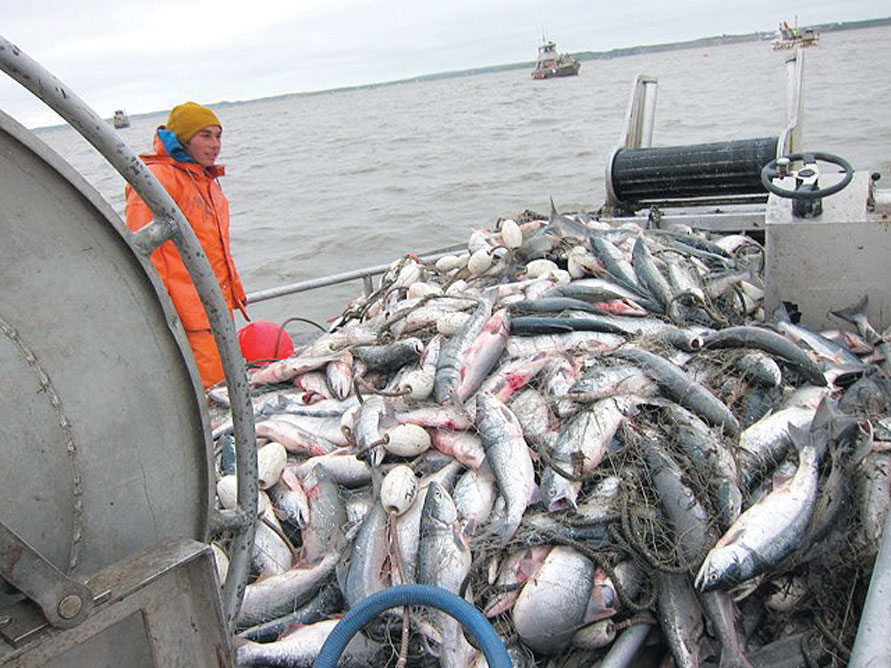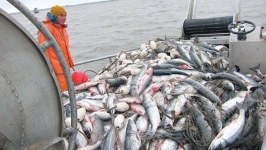Salmon Run
A Teenager, a Life Lesson and 16,000 Pounds of Alaskan Fish
 I became a commercial salmon fisherman mostly because I despised the idea of a boring teenager summer job in New Jersey. I wanted to experience the soul-enriching beauty of the wild, uninhabited and natural landscape. I wanted adventure. I wanted a challenge. And I wanted money.
I became a commercial salmon fisherman mostly because I despised the idea of a boring teenager summer job in New Jersey. I wanted to experience the soul-enriching beauty of the wild, uninhabited and natural landscape. I wanted adventure. I wanted a challenge. And I wanted money.
I was apprehensive. I had no fishing experience. A friend, who had worked a similar job, warned me of the risks and challenges. He was deceivingly nonchalant. Over the phone, my captain, Justin, was more blunt. To be a salmon fisherman in Alaska would require a sustained level of focus. Without a certain attention to detail, I could endanger myself and everyone who would work with me. I did my best to sound confident.
I agreed to fly to Egegik, Alaska, a remote town beside Bristol Bay, on June 7, 2017. There, I would stay for 47 days and receive 7.5 percent of our boat’s earnings—a generous rate for a greenhorn. I would buy my own gear. My captain would pay for half the roundtrip airfare from Seattle to Egegik. We had an agreement, but I never signed a contract.
I was in awe of the landscape—the endless expanse of verdant tundra speckled with cerulean, translucent lakes, the snow-covered volcanoes in the distance—and the wildlife. I could never get used to the constant patrol of bald eagles, flying up and down the shoreline where we stayed, or the red fox that would hang out within feet of us because some people fed it. The absence of trees and flat topography only contributed to the sense of solitude in this vast and empty environment. The sun circled around the horizon, igniting the firmament for a couple of hours before briefly setting around midnight. A day felt like a week, a week felt like a month, a month felt like a year. The sky seemed impossibly wide and so massive I could feel its weight pressing down on me. I was in the Alaskan altered state of consciousness and felt tremendously fortunate.
Ryan and I were crew on Justin’s drift boat, the Jaqulin. Ryan and Justin are both hardworking, tough and honest men. Jaqulin is a modest boat. She gave us plenty of trouble and was consistently the slowest boat in the water, yet she could get the job done. Unlike most other drift boats, Jaqulin doesn’t provide space to sleep. We came ashore and slept on land. This may sound like a good thing, and it is, until you are fishing 20 hours a day and missing out on precious sleep because you must come ashore.
The first few times we fished were exhilarating. Simply being on the water and observing the seals, sea otters, beluga whales and tides is fascinating. During a full and new moon (a spring tide), Egegik’s tidal range is more than 20 feet. The resulting currents are swift and dangerous. The possibility of going overboard was terrifying, especially considering the density of boats in the water. The previous year, a kid my age went overboard, was crushed between two drift boats and died. The bay consists of a labyrinth of sand bars that appear and disappear rapidly as the tide changes. On the ebb, drift boats become grounded on invisible sandbars that are suddenly exposed, and must wait for the flood, sometimes missing hours of fishing.
Bristol Bay fisheries are strictly regulated and well managed. As a result, the sockeye salmon runs are strong. The total Bristol Bay run has averaged 42.7 million fish (per year) in the last 10 years, whereas the average from 1963 to 2017 was 33.8 million fish. Bristol Bay commercial salmon fishers are allowed to fish only during specific times, called “openers.” Biologists determine when and for how long we are open. Directly before an opener, the drift boats try to locate the best spot. At the second the opener starts, hundreds of nets are set and the river is suddenly cut off. Then we drift with the tide, dragging the net in whatever direction is necessary. Ryan and I frantically connect and disconnect the net to various parts of the boat, so Justin can position the net to catch the most fish, avoid other boats’ nets and avoid crossing the boundary line. When Justin thinks we have caught enough fish or cannot catch any more fish on a set, we start picking. When we reel in the net, salmon are suspended in the net, with the mesh stuck in their gills.

PHOTOGRAPH: COURTESY OF JESSE MCDERMOTT-HUGHES
We caught 36,000 pounds of salmon over three days on approximately four hours of sleep. At certain points throughout this saga, I lost all hope and found myself in a negative mindset, pondering how stupid I was to think I could be a salmon fisherman.
Picking fish fast is necessary to make a lot of money. It can be gruesome. It requires sticking your fingers into the gills of the fish and prying the mesh from their gills. It became much harder if I recognized that I was killing such a magnificent creature. For the first two weeks, I picked slowly. Luckily for me, there were not many fish. We fished when there were openers, but that wasn’t enough. The run was late. We were closed for several days when the season typically peaks, and stress levels were skyrocketing. Fishermen depend on a strong run and a reasonable price to make their investment worthwhile. If the run is weak or the price is low, fishermen suffer.
On July 1, Egegik was hit with a wall of fish like no one had seen. I vividly remember the bay teeming with sockeye salmon jumping for joy. I was dumbfounded. To this day, even after asking knowledgeable fishermen, I am unsure why the salmon jump. The impression I got was that these salmon had traveled hundreds of miles and had finally arrived at the river where they were born and will spawn, so they were happy. It is typical of any season to see a few fish jumping out of the water, but this year was different. There was an unprecedented density of salmon in the river.
The next day, we were finally open. As soon as the opener started, everyone’s nets were exploding with fish. That set on July 2 was a 10,500-pound set. We tried to pick through the net methodically, but too many other boats were around, so we were forced to “round-haul.” Instead of picking through the net as it we reeled it in using the hydraulics (a machine) and tossing the fish into holds, we dragged the net with 10,500 pounds of fish into the boat and piled it up on the deck using manpower almost entirely. I cannot imagine anything more physically demanding.
With that many fish on our deck, we were on the verge of sinking and could barely get any thrust. We spent most of that night picking through the net. We delivered the fish at 4am, slept for two hours, and fished two openers the next day, catching another 14,000 pounds of fish. We got another two hours of sleep. Subsequently, we caught 12,000 pounds on one set and were forced to round-haul again. We caught 36,000 pounds of salmon over three days on approximately four hours of sleep. Meanwhile, Ryan had injured his hand and it had swollen like a balloon, yet he somehow continued to work. At certain points throughout this saga, I lost all hope and found myself in a negative mindset, pondering how stupid I was to think I could be a salmon fisherman. Strange welts (a reaction to fish slime?) appeared all over my hands, wrists and forearms. Every part of me ached, and I felt as though I had pushed my body as far as it could go. I was wrong. Ryan and Justin taught me that with a certain level of mental fortitude, one can push one’s body to a remarkable extent.
Over the next three weeks, we continued to fish on only a few hours of sleep. The run was strong, we were open constantly. I began to understand how to pick fish fast and it became my best asset. However, I was lonely and mentally fragile in a way that I had never been. I hadn’t seen my family in seven months. I found myself crying uncontrollably. My dreams were vivid and sometimes terrifying. At one point, I dreamed I had become caught in the net, awoke suddenly, thrashing in my mosquito net, and rolled out of bed onto the floor. A random line of some song I may not even like would be stuck in my head for days and continue on an endless loop. I was losing my sanity.
A break in the cold, rainy, windy weather would briefly lift my spirits. If I could focus on the beauty of my surroundings I could find motivation to keep going. While we did fall into a monotonous routine, there were still many surprises. Stormy weather could arrive without warning. Usually, we would keep fishing, but one time the wind was so strong and swells so violent, we were forced to stop. We felt lucky to make it to shore. Encounters with grizzlies became common. Once, Justin was forced to shoot at a bear that had become too comfortable hanging around the camp. I was shown how to use a shotgun and slept with one beside my bed. On my 19th birthday, my foot became caught in the net and I nearly went overboard. Fortunately, my boot popped off, leaving me safely on the boat, but without a rather expensive boot. It was a memorable birthday.
When I left Egegik, we had caught 116,000 pounds of fish. I had become close friends with Ryan, a man with a kind heart and a will of steel. I had become fascinated with salmon fisheries and decided to focus my collegiate studies around them. I felt I had matured more in 47 days than I had in the rest of my entire life. I was a new person with a fresh perspective. And I had earned a boatload of money.
The next time you buy salmon, make sure it’s wild, Alaskan salmon, preferably from Bristol Bay. Why? Well, for one thing, you would know you are making an environmentally responsible decision.
Also, trust me, it tastes better than any other salmon you will ever find.
Editor’s note: The blue label from the Marine Stewardship Council offers an assurance to consumers that Alaskan salmon products can be traced back to a certified sustainable source.






